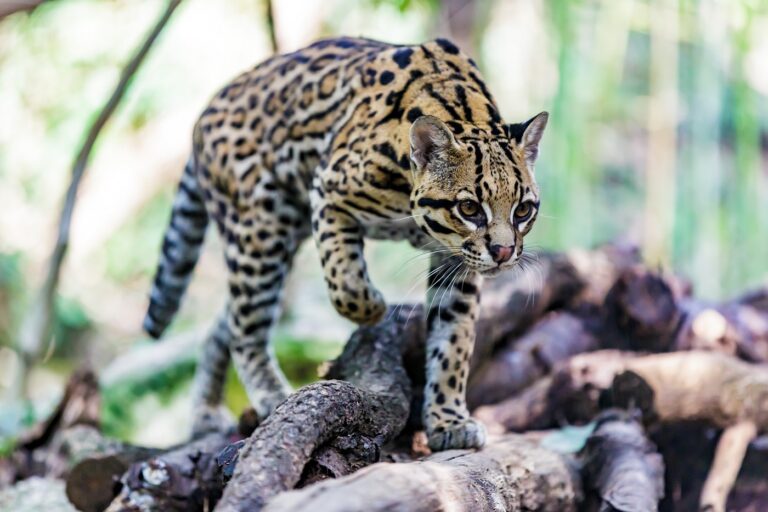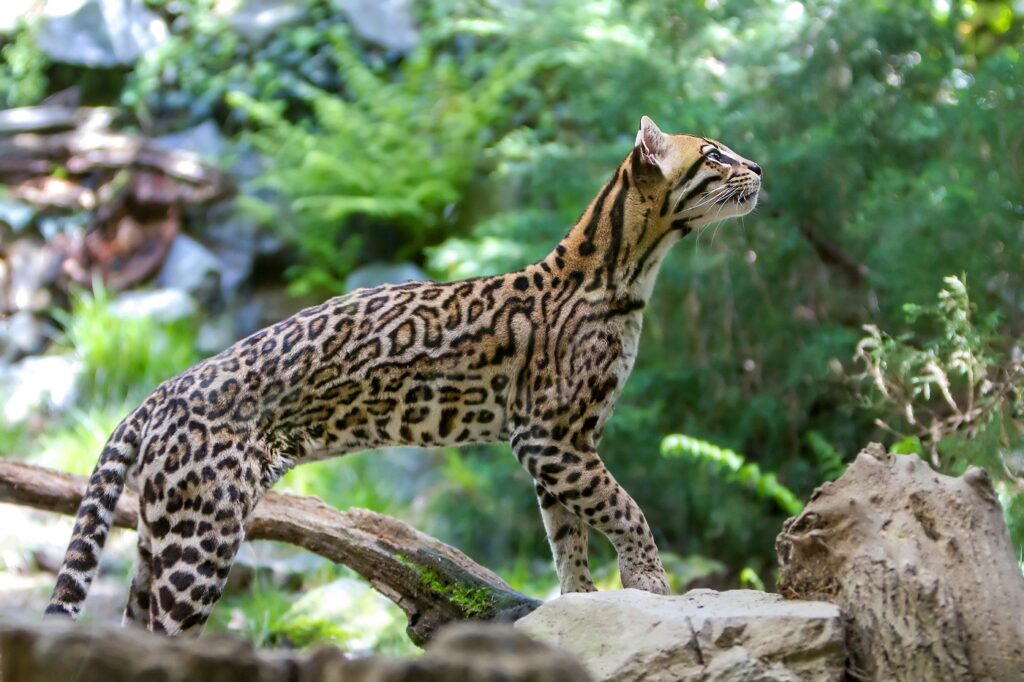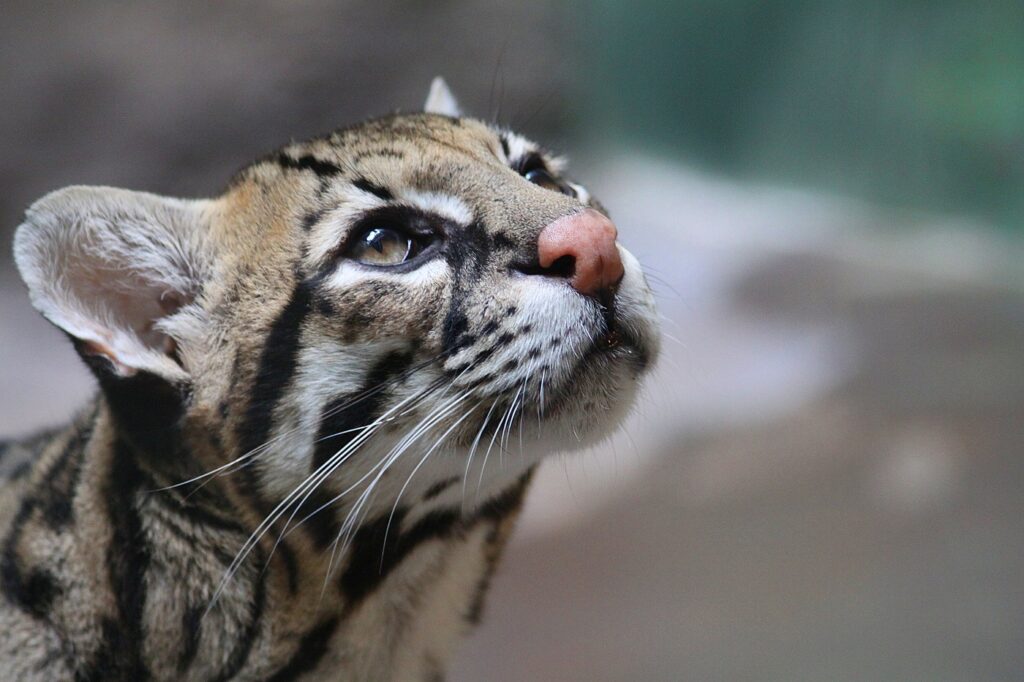Maine Coon
The Maine Coon has become one of the most popular cat breeds in the world. This is probably due to its majestic appearance, robust nature and great character.
The ocelot (Leopardus pardalis) is a wild animal inhabiting the forests and scrublands of Central and South America. It roams as a nocturnal loner, hunting rodents, reptiles, and fish. Its attractive fur made the ocelot a sought-after target for hunters for a long time, causing their numbers to dwindle. However, the species is now protected and not currently endangered.

© saad / stock.adobe.com
The ocelot is a rather sturdy member of the small cat family and an excellent climber.
| Quick Info: | Ocelots inhabit forests and savannas. They are excellent climbers and swimmers. |
| Head-Body Length: | 55-100cm |
| Weight: | up to 10kg females, up to 15kg males |
| Average Lifespan: | Up to approx. 10 years. In captivity up to approx. 20 years |
| Behaviour: | nocturnal, solitary |
| Fur: | short, dense, fine |
| Fur Colours: | base colour grey to ochre or orange-yellow, with individual rosettes, spots, and stripes |
| Training Effort: | not domesticable |
| Origin: | Central and South America |
With a body length of 55 to 100 centimetres, the ocelot is about twice the size of an indoor cat, making it a medium-sized small cat.
The tail is relatively short, measuring about 25 to 41 centimetres in length. The weight ranges between seven and 15 kilograms, with males being larger and heavier than females.
The build is sturdy and muscular. The animals have strong limbs and retractable claws, making them excellent climbers. Ocelots have large, brown eyes and rounded ears.
Ocelot fur is short, dense, and fine. Its base colour varies depending on its habitat. Those living in humid, warm forest areas are ochre to orange-yellow in colour. In contrast, ocelots in dry savanna regions sport a more greyish coat. The belly is lighter in all animals, almost white.
The fur features various patterns like rosettes, rings, spots, and stripes. Each ocelot has a unique pattern. Often, the left side of the body is differently patterned than the right.
 © elitravo / stock.adobe.com
© elitravo / stock.adobe.com
Ocelots are mainly found in Central and South America. Their range extends from the southern USA through Mexico to Colombia, Peru, and Argentina. They are also found on the island of Trinidad. The largest population resides in the Amazon Basin.
The animals occupy diverse habitats, such as tropical rainforests and dry mountain forests. Besides forest areas, the medium-sized cats are also found in scrublands and savannas, as well as near settlements. However, they usually avoid open areas, relying on undergrowth and bushes for successful hunting.
Ocelots are solitary creatures. They hunt mainly at night or at dusk and sleep during the day. On overcast, cool days, they may sometimes be active before sunset.
Typically, they spend the day hidden in tree hollows or high up on branches. They not only climb well but are also good swimmers.
At night, ocelots roam their territory. In search of food, they cover several kilometres daily, with males travelling further than females. Territory sizes can vary between 2 and 31 square kilometres. Males generally have larger territories than females.
Ocelots mark their territory with urine and faeces as well as scratch marks on trees. The territories of males and females can partly overlap, whereas same-sex individuals are not tolerated within the territory.
Ocelots’ diet includes rodents like agoutis, porcupines, and opossums, as well as larger mammals like howler monkeys, sloths, and smaller deer.
Although they are good climbers, the small cats mostly hunt on the ground. Occasionally, they catch a bird. Other prey includes reptiles like iguanas, caimans, and snakes, as well as amphibians, fish, shrimps, and insects.
Usually, the animals hunt while on the move. They can also patiently ambush their prey. Some ocelots, for instance, specifically target agouti nests, waiting for the rodents to emerge.
Males and females only meet for mating, which occurs in cooler regions in autumn. In the Ocelots’ tropical range, there seems to be no fixed breeding season.
Following a gestation period of about 80 days, the female gives birth to one to three young, raising them alone. She builds a sheltered nest, often in tree hollows or rock crevices.
The kittens are born blind, weighing 200 to 280 grams. After about two weeks, they open their eyes. A week later, they begin to walk.
The young follow their mother on hunts, becoming increasingly independent. At around three months, they separate. However, the mother tolerates the growing kittens in her territory for about two to three years before they must find their own territory.
Natural enemies of Ocelots include larger cats like jaguars and pumas, as well as giant snakes and birds of prey.
However, the greatest threat is humans. Previously, the animals were heavily hunted for their fur. Today, trading ocelot fur is banned under the Washington Convention (CITES). Still, they are occasionally hunted illegally.
A bigger threat than poaching is the destruction of their habitat. The animals need the cover of undergrowth and bushes to hunt successfully. In populated areas, many animals fall victim to road traffic.
Since being protected, ocelot populations have recovered in many areas. Therefore, the species is currently classified as “not endangered”. However, ongoing rainforest deforestation and habitat destruction could soon nullify this success.
 © Julie / stock.adobe.com
© Julie / stock.adobe.com
The ocelot is a wild animal and not suitable for keeping as a pet. Nevertheless, young animals are still occasionally captured and illegally offered for sale.
Animal lovers should never acquire an ocelot: adequate housing in private hands is simply not possible, and it is usually strictly prohibited or highly regulated.
To see an ocelot, you can visit a zoo. Many European animal parks showcase these spotted small cats, often promoting nature and species conservation projects in Central and South America.
Many people are fascinated by these graceful South American cats and their beautiful fur patterns. Photos and videos of wild cats in private households often circulate on social media. The fact is: ocelots are wild animals and do not become tame.
An alternative for cat lovers is the Ocicat breed. It looks like a wild ocelot but is a domesticated breed created by crossing Siamese and Abyssinian cats. The Ocicat is not one of the problematic hybrid cats from an animal welfare perspective but a true indoor cat.
Although ocelots are not currently critically endangered, their habitat is continually shrinking. The illegal trade in fur and live young harms the wild population, so true animal lovers should avoid buying them.
The Maine Coon has become one of the most popular cat breeds in the world. This is probably due to its majestic appearance, robust nature and great character.
Large eyes and attentively upright ears instantly tell you a great deal about this charming breed of cat: Abyssinians are inquisitive and affectionate towards people.
With its long, dense fur, rounded ears, and intense stare, the Pallas Cat, or Manul, looks rather fluffy, yet somewhat dangerous. However, don't be fooled by its appearance—this is no petting zoo resident. The Manul is a wild animal and considered untameable.